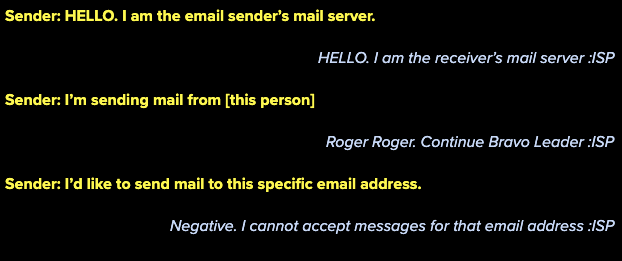
Oct 7, 2019
Einblicke in E-Mail-Validierungstechniken
Von der Konformität mit regulären Ausdrücken bis hin zu den heutigen hochentwickelten Tools hat die E-Mail-Validierung verschiedene Epochen durchlaufen. Bevor Sie sich mit der Geschichte der Validierungstechniken und Best Practices befassen, sollten Sie die Grundlagen verstehen.
Was ist E-Mail-Validierung und warum ist sie wichtig?
Die E-Mail-Validierung ist eine Methode zur Überprüfung, ob die Adresse eines Empfängers existiert und Nachrichten annimmt. Einige Verfahren gehen bei der Validierung noch einen Schritt weiter, indem sie bestätigen, dass die Adresse der vorgesehenen Person gehört und der Empfänger solche Mitteilungen erhalten möchte. Während dieses Prozesses werden Sie riskante und ungültige Adressen aus Ihrer Liste entfernen und Ihren Namen als seriöser Absender bei Internetdienstanbietern (ISPs) schützen.

Durch die sorgfältige Validierung von Benutzer-E-Mails vor dem Versand von Marketing- und Transaktionsnachrichten erhöht sich auch die Wahrscheinlichkeit, dass Ihre Mitteilungen direkt an die Adresse des Lesers inbox geleitet werden.
Vor langer Zeit, in einer weit, weit entfernten Ära... begann es mit Syntax-Validierung
Checking an email address for syntax accuracy has been the simplest version of email validation. Die core elements of a valid email address are the local part, the @ symbol, the domain, and finally, the extension (.com, .org, etc.). To help standardize all the various syntaxes, specifications called Requests For Comments (RFCs) were published to determine what characters would be acceptable for local and domain parts. These RFCs eventually became quite extensive and created the need for open-source libraries to help validate email syntax in many languages.
Eine weitere wichtige Komponente der Syntaxvalidierung sind offensichtliche Rechtschreibfehler, wie z. B. heyitsme@gmsil.com. Die Überprüfung Ihrer bestehenden Liste auf diese Art von Fehlern ist nach wie vor eine bewährte Praxis.
Validierungs-SMTP-Befehl und der Angriff der Spammer
Da der Bedarf an Hilfe bei der Überprüfung von E-Mail-Adressen erkannt wurde, begannen die Internetdienstanbieter (ISP), Funktionen zur Überprüfung von E-Mail-Adressen einzubauen. So wurde "VRFY" (auch bekannt als "Verify") als SMTP-Befehl entwickelt, der es Absendern ermöglichte, einen empfangenden Mailserver zu fragen, ob eine E-Mail-Adresse gültig ist. In der Hoffnung, mit VRFY Frieden und Ordnung in das galaktische Internet zu bringen, geriet es bald in die falschen Hände der dunklen Seite: der Spammer. Nachdem diese Funktion in großem Umfang missbraucht worden war, deaktivierten die ISP-Administratoren VRFY und ließen die Überprüfung von E-Mail-Adressen im Sande verlaufen.

SMTP Ping (Die Spammer-Bedrohung)

Nach dem Fall von VRFY entwickelten die Absender kreativ SMTP Ping, eine andere Methode, um zu überprüfen, ob eine E-Mail-Adresse gültig war oder nicht. Mit SMTP-Ping wird ein entfernter Mailserver überprüft, um festzustellen, ob eine E-Mail-Adresse noch gültig ist. Eine Verbindung zum entfernten Mailserver des Internetdienstanbieters (ISP), wie z. B. Gmail, wird hergestellt, als ob tatsächlich eine E-Mail gesendet würde, aber abrupt abgebrochen, ohne dass die E-Mail tatsächlich gesendet wird.
In der Regel sieht die Konversation in der Verbindung zwischen dem sendenden Mailserver und dem empfangenden ISP-Mailserver wie folgt aus:

In einigen Fällen könnte der Internetdienstanbieter stattdessen eine Rückmeldung wie diese geben:

Mit SMTP Ping konnten die Absender die Konversation abbrechen, nachdem sie die Antwort des Internetdienstanbieters gesehen hatten, nachdem sie angefragt hatten, E-Mails an die angegebene E-Mail-Adresse zu senden. Auf diese Weise wurde es möglich, einen ISP anzupingen, um festzustellen, ob der empfangende Mailserver die E-Mail-Adressen mit einem gewissen Maß an Sicherheit für gültig oder ungültig hält.

Die dunkle Seite von SMTP Ping
ISPs consider SMTP Ping — also known as the broken handshake — as spammer behavior. ISPs can easily tell that you’re just checking validity of email addresses by looking am conversation patterns: Calling in and hanging up repetitiously, with no (or very little) messages actually being sent, ends up in their mail server logs. After the history with SMTP VRFY, this type of behavior is now known to be spammy. ISPs are cracking down on this behavior and cracking down hard. Microsoft for example, considers this type of practice to be malicious and Hotmail finds SMTP Ping as evidence of a directory harvest attack. SMTP Ping attempts in progress will typically drop a hard block on all connections from the sending IP address. ISPs dislike SMTP Ping, and so do blacklist operators. Keep it up, and you’ll almost surely end up getting blacklisted.
Darüber hinaus verzögern viele Internetdienstanbieter die Überprüfung des Empfängers bis nach dem Ende der Serverkonversation, was zu einer Annahme ohne Bestätigung der Gültigkeit der E-Mail-Adresse führt - ein falsches Positiv. Einige Internetdiensteanbieter schützen die Empfänger auch durch eine graue Liste. Bei Protokollen mit grauer Liste lehnt der Empfangsserver E-Mails von unbekannten Absendern ab. Infolgedessen geben SMTP-Pings auch bei gültigen E-Mail-Adressen eine Fehlermeldung zurück - ein falsches Ergebnis.
Langer Rede kurzer Sinn: Das ist eine wirklich schlechte Praxis und unzuverlässig.
Mögen die Überprüfungen mit Ihnen sein - Best Practices für die E-Mail-Validierung
Es gibt verschiedene Maßnahmen, die Sie ergreifen können, um sicherzustellen, dass Ihr Ansatz zur Validierung von E-Mails solide ist, darunter:
Gehen Sie proaktiv mit Tippfehlern um: Consider adding an auto-complete tool to your email entry field with popular @example.com extensions, such as @gmail.com. Allowing users to select from the preformatted entries reduces the potential for a typo.
Entscheiden Sie sich für das Double-Opt-In: Sending an email confirming a user request that requires them to verify their email satisfies regulations for certain markets and provides validation.
Nutzen Sie die Vorteile der Technologie: Various email verification tools offer an easy, affordable way to maximize communication potential and maintain friendly relationships with ISPs.
Schaffen Sie eine Routine: While it may be tempting to validate emails only when executing a bulk-send campaign, regularly scheduling a validation may be the better option. Consider how often and from where emails join your list — the more options for capturing contact information, the more potential for invalid addresses.

Why Use Email Validation Tools?
Es gibt viele Gründe für den Einsatz von E-Mail-Validierungstools (EVs), darunter:
Es spart Ihnen Zeit: EVs rely on automated processes for validation that reduce the time associated with manual look-ups.
Das spart Ihnen Geld: A clean email list with valid addresses eliminates bounces and increases ROI by reducing unnecessary spending.
So werden Sie nicht auf die Blockierliste gesetzt: Using EVs lowers spam complaints that can lead to message and sender blocking.
Sie verbessert die Zustellbarkeit: Readers need to receive your emails before interacting with them, so deliverability is a priority for promotional and transactional communications.
Es bietet Ergebnisse in Echtzeit: Being able to validate immediately across different points of the buyer’s process supplies you with higher-quality contact information.
Eine neue Hoffnung: Datengesteuert
Rather than rely on SMTP Ping, there’s a different data-driven approach that does not make enemies with ISPs. Validating email addresses can be done by looking up against a large data set, with event data including hard bounces, deliveries, and engagement, as well as incorporating syntax validation, typo detection, DNS queries for valid domains, and quality checks for free, role-based, and disposable email addresses. This method heavily relies on the depth and breadth of the data the email validation tool or service is built upon, instead of depending on the ISP to provide back a specific response. You may not want to judge Master Yoda based on his size, but you’ll want to judge an email address validation tool by its data size.
SparkPost’s Validierung des Empfängers is built on top of its large email data footprint, sending more than 37% of the world’s B2C and B2B email. Our data science team has done a thorough analysis of billions of email bounces and delivery events. Our findings establish that a single hard bounce isn’t enough to establish you shouldn’t send to an address. Using our data footprint, we are constantly updating our list of recipients and our algorithms to capture the true validity of a hard bounce, and analyzing all related email events to best answer the question: Can you deliver to this given email address?
As we continue to build and iterate upon our Validierung des Empfängers, our goal is to make ours the most dependable and fastest validation tool on the market. Rumor has it our Recipient Validation will be able to make the Kessel Run in less than 12 parsecs, or at least something along those lines…
